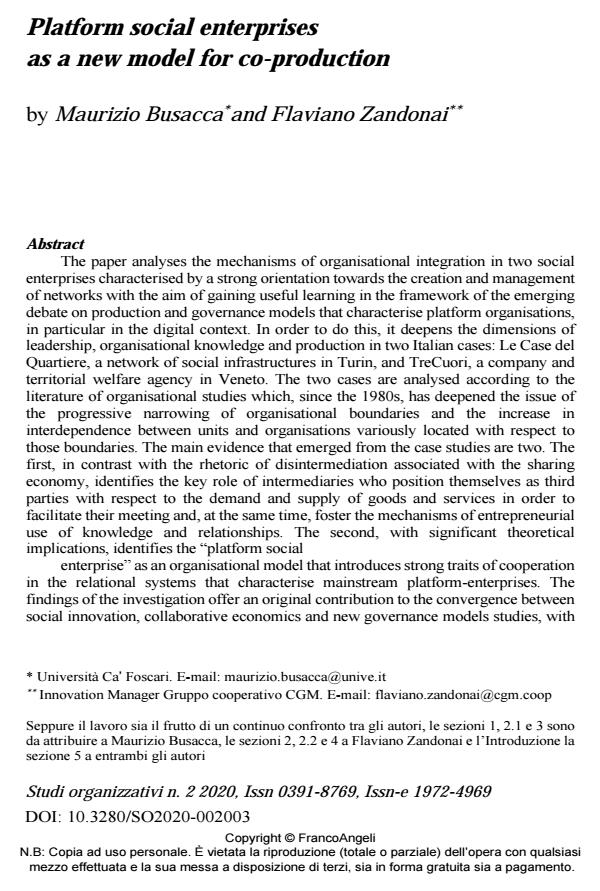Platform social enterprises as a new model for co-production
Journal title STUDI ORGANIZZATIVI
Author/s Maurizio Busacca, Flaviano Zandonai
Publishing Year 2020 Issue 2020/2
Language English Pages 26 P. 61-86 File size 334 KB
DOI 10.3280/SO2020-002003
DOI is like a bar code for intellectual property: to have more infomation
click here
Below, you can see the article first page
If you want to buy this article in PDF format, you can do it, following the instructions to buy download credits

FrancoAngeli is member of Publishers International Linking Association, Inc (PILA), a not-for-profit association which run the CrossRef service enabling links to and from online scholarly content.
The paper analyses the mechanisms of organisational integration in two social enterprises characterised by a strong orientation towards the creation and management of networks with the aim of gaining useful learning in the framework of the emerging debate on production and governance models that characterise platform organisations, in particular in the digital context. In order to do this, it deepens the dimensions of leadership, organisational knowledge and production in two Italian cases: Le Case del Quartiere, a network of social infrastructures in Turin, and TreCuori, a company and territorial welfare agency in Veneto. The two cases are analysed according to the literature of organisational studies which, since the 1980s, has deepened the issue of the progressive narrowing of organisational boundaries and the increase in interdependence between units and organisations variously located with respect to those boundaries. The main evidence that emerged from the case studies are two. The first, in contrast with the rhetoric of disintermediation associated with the sharing economy, identifies the key role of intermediaries who position themselves as third parties with respect to the demand and supply of goods and services in order to facilitate their meeting and, at the same time, foster the mechanisms of entrepreneurial use of knowledge and relationships. The second, with significant theoretical implications, identifies the "platform social enterprise" as an organisational model that introduces strong traits of cooperation in the relational systems that characterise mainstream platform-enterprises. The findings of the investigation offer an original contribution to the convergence between social innovation, collaborative economics and new governance models studies, with a shift from "platform capitalism" to "platform cooperativism" by organizations that use place-based social innovation models and give importance not only to relational and political-cultural factors, but also to co-production, co-working, collaboration and networking. Observed from this perspective, the platform social enterprise becomes a model to be more considered in order to propose a more cooperative, sustainable and democratic development trajectory of platforms.
Keywords: Platform Organisation; Common-Based Peer Production; Social Innovation; Collaborative Economy; Organisational Boundaries; Networked and Distributed Organisation
- Redesigning Meso-Institutions in the Social Economy to Deal with Uncertainty: The Case of CGM Network Francesca Battistoni, Giulio Quaggiotto, Flaviano Zandonai, in Sustainability /2024 pp.1277
DOI: 10.3390/su16031277 - Still Informal? Care Platforms in a Loosely Regulated Context, the Italian Case Luisa De Vita, Andrea Ciarini, in Critical Sociology 08969205241306449/2025
DOI: 10.1177/08969205241306449 - Ridisegnare le meso istituzioni dell'economia sociale per affrontare l'incertezza. Il caso del Consorzio nazionale CGM Francesca Battistoni, Giulio Quaggiotto, Flaviano Zandonai, in STUDI ORGANIZZATIVI 1/2024 pp.112
DOI: 10.3280/SO2024-001004
Maurizio Busacca, Flaviano Zandonai, Platform social enterprises as a new model for co-production in "STUDI ORGANIZZATIVI " 2/2020, pp 61-86, DOI: 10.3280/SO2020-002003